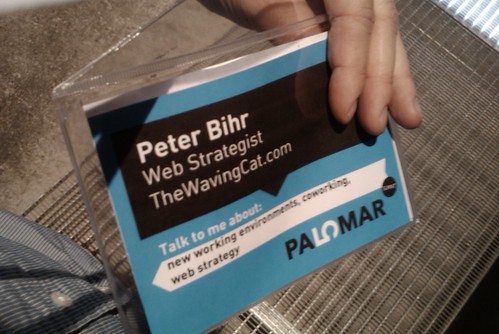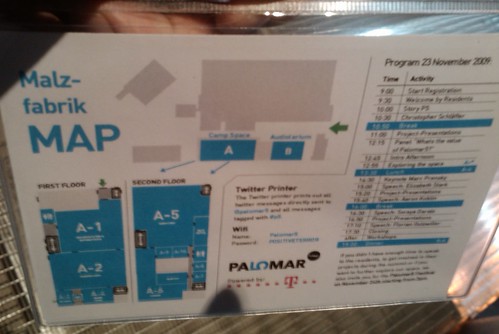 Even though a few friends of mine have been directly involved in the project, I had been watching Palomar5 from a distance. (Mostly because I was literally, physically far away.)
Even though a few friends of mine have been directly involved in the project, I had been watching Palomar5 from a distance. (Mostly because I was literally, physically far away.)
I spent most of the day there and came away with a lot of impressions, and also pretty impressed. Let me share a few things I noticed during the day.
But first, to get an idea what Palomar5 is, let me quote from their website:
Palomar5 is looking for creative young minds all over the world to propose new working environments fit for the skills and needs of a digital generation. Palomar5 and affiliate curators are currently giving 30 residents the possibility to stay for six weeks in an Innovation Camp in Berlin. This is a chance for collaboration as well as self-expression. This is an opportunity to network with leaders from economy, science, culture and politics and to meet experts at the forefront of their fields. The residents are passionate, eager and full of ideas, Palomar5 is a 2000sqm incubation-space that’ll make them blossom. They’ve got the ideas, and we have a place for them to make them real.
And furthermore:
Innovation has been increasingly popularized into becoming a trend and a commodity. There are numerous enterprises, think-tanks, and conferences solely devoted to the mass production of innovation. Unfortunately one can put wings on a shopping cart and sell it as Innovation at a high price. But when it comes to questioning and reforming prevailing paradigms there is too much talk and not enough action. Lot’s of coloured bubbles. Lot’s of profit. No real help. Palomar5 was established as a non-profit initiative seeking innovation outside of corporate structures. The founders of Palomar5 feel that “innovation” itself is in need of reformation.
The whole project is backed by Deutsche Telekom and a few smaller sponsors, and clearly those sponsors were serious about Palomar5. They rented an old industrial complex and refurbished the interior to house 30+ participants for six weeks, including some major workspace, today’s summit and to allow for the participants to prototype or build all kinds of stuff. It really all looked quite impressive and well done.
More than the location though I liked how clearly you could see the intense group dynamics going on between the Palomar5 folks. They had been locked up together for six weeks in this cool playground setting (that had the feel of some massive hacker space-meets-design school), and the effect was a group bonding that seemed to foster a lot of creativity, and it’s also clear that those 30 “youngsters” (as they are unfortunately called in the image trailer) will keep in touch with their fellow colleagues. No doubt, we’ll see some cool projects come out of these networks in the future.
To give you an idea of what kind of things the groups came up with (in completely random order): a massive hollow egg that serves as a room of peace and quite to retreat to in case of stress; an RFID-based set of screen and cards to transmit information in a haptic, physical way. And, what I personally found most intriguing, a network of 16 communications satellites that would provide broadband for rural areas all over the world – to be built under the premise that access to information is a human right.
The mindblowing part here: according to the team’s estimates this could be done with a mere 1.72 billion dollars. That’s quite a sum, but taking into account that the German cash-for-clunkers program (the so-called Abwrackprämie) is estimated to cost altogether $3.5b, while the US economic stimulus package was set at an even steeper $789b, it seems really doable. How awesome would that be?
There were, of course, a thing or two that weren’t perfect. For one, this project was clearly fueled by big money and a lot of adrenaline, both of which tend to burn quick and brief. How successful it really is will only become clear when we look back in six months or so and see how the projects and personal connections will have evolved.
And more concretely, almost every presentation given indicated that the young generation, the so-called digital natives, were smarter, better, and more in-the-know than the “old generation”. Everything was made to be the result of a generation gap, and that the “old corporations” would be losing this generation both as customers and employees. While the latter point certainly isn’t completely untrue, I don’t think at all that “getting” the web & digital culture with all their special characteristics like network effects, real-time communication and always-on culture is a matter of age or generation.
In fact, I believe that going down that path is a fairly dangerously wrong perception, it’s lying to yourself. I know many people (and I’m sure you do, too) who are way to old to fit the digital natives label, yet they really know their digital stuff. On the other hand, not everybody below 30 would fit that description either. So these labels are inaccurate and poorly stereotyped. What’s more, it’s arrogant, and that’s a danger in itself. (Not to mention that these 30 folks wouldn’t have gotten this opportunity without the older folks funding them because they do get it. By trying to erect that odd native/immigrant barrier no good is done to either side. (Which by the way goes for digital as well as other areas where this terminology is used.)
But be this as it may, while I don’t agree to this particular point in the arguments, what the organizers and the team of Palomar5 have put together here is a true feat, and something they can be proud of. It’s also a promising model for other corporations to get a bunch of good ideas while giving a hand full of young folks to gain experience. It’s a classical win/win. And I’m curious to hear more stories from inside the workshop over the next few weeks, once the participants are released back into the normal world…
ps. The Palomar5 Summit name badges are hands down the best I’ve ever seen at any conference. They are huge (roughly the size of my hands), well readable, and include all the information you’ll need at the conference: Participant’s name, company and URL and tags on the front. On the back you find program, floor map, hashtag, conference twitter account, wifi password, sponsor info and a reminder of the next day’s party. No more stupid flyers!



6 Comments
Thanks for this great post Peter, I could not agree more. I also tend to think that its not really about age either. Of course young people think different, they always do, but I’m not finding it very convincing to generalize ‘old’ people in another category. While these are all very talented people, I know a lot of young people who share very conservative ideas about technology too. A lot of times, they are not even aware of these discourses either actually…
And thanks for the comment on the badges, we enjoyed designing them!
Twitter was awfully quiet, at least compared to Atoms&Bits and BarCamp Hamburg, so thanks for the speedy write-up Peter!
It’s an exiting project, and I like the idea of someone paying “first class” so that the “backpackers” (us?) can hitch a ride.
It seems to me that the big companies still want to build “Star Trek”, unfortunately they seem to be engaged in building “Borg Cubes”, not the “Enterprise” – strangely enough “the egg” you describe sounds very Enterprisy/Holodecky – a more human vision than the big corps can come up with – inspiring!
It might prove difficult to get this to take off in the long term, after the euphoria has died, despite our communication tools this seems to be an issue.
But thanks to twitter, really the first tool since RSS, that seems to be able to keep us talking, I’m actively following this from afar! I’m optimistic, as always, and we do need this focus on innovation to get us out of the current crisis.
Edial, you guys did the badges? GREAT job! If I ever get to organize another event, could I get you to do the badges there, too? ;)
Were you a participant at Palomar5, or involved in the organization? I really enjoyed the day there. A lot. It’s a great mix of people. Although it was very clear that there was quite a culture clash between the participants and the “suits” in the first rows. (Like when Jay asked them to please take off their ties..)
Also, Roel and I have been trying to meet up for quite some time. I’m sure we’ll make it soon. Hope you’ll join in, too?
Kim, thanks a lot for your feedback. Indeed not too much was on Teh Twitter today. Partly this may have been due to the moderator asking the audience to really pay attention and not to play around with their phones ;)
And I agree 100% with you on the Star Trek Enterprise vs Borg Cube point. Great metaphor, too! A number of the projects introduced at Palomar5 were of the more human / social / “soft factor” (what a weird expression…) kind. One I found quite funny was a participant who would, for I believe $5, tell you her impression of you – totally honest, unfiltered by social protocol and politeness. Quite interesting thought (even though I’m not sure why I would ask a random person for honest feedback and not my friends, but that’s a different question).
But back to Enterprise vs Borg Cube: I’d guess that the less human (i.e. Enterprise), more corporate/technological/commercial (i.e. Borg Cube) are not just more easily understandable from a corporate culture point of view. They also seem more intuitively commercially viable than the more new school “sharing is caring” kind of ideas (which I believe can hold tremendous commercial value, but it’s often less obvious).
So for the time being, I’d say let’s accept that maybe sometimes major corporation willing (for true motivation or for hype) to fund the space that’s needed to develop good ideas might be a good way to go. I’ve seen several projects of this kind recently and have to say it can work quite well if the company doesn’t fall for the marketing trap, i.e. if they don’t give in to the marketing department’s urge to plaster the company logo all over the place…
But of course this is just a personal opinion, and a lot can be said against it… Curious on your take!
Great that twitter is silent, but…there should have been a “tweetmaster” – IMHO it’s a REQUIRED role of a facilitation team these days.
Back to the comment. You and I know that “less is more” – you can gather the same people without overdoing the corporate mentions – case in point was the recent Copenhagen Cocoa Developer Conference – where NO banners and corporate logos were present, even though we had received rather massive sponsorships – I must admit that I was stunned by this.
I too am very supportive of, and exited by, what big businesses, like Telekom seems to be doing here, and I loved their quite low-key presence at reboot11.
The “soft factor” is EXACTLY what we need, totally following your point here.
Looking forward to where this is taking us, go humanity I’m your number one fan!
Sure! We can do badges anytime, haha.
I was participant in the first Palomar5 camp, the micro-camp, some months after that, we moved to Berlin. Then we did the logo, website, twitter printer, badges and some other things for them.
We should definitely meet up, I’m sure the rest of our team would also join us! You’re always free to co-work here too by the way.